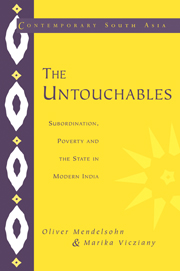Book contents
- Frontmatter
- Contents
- List of tables
- Glossary
- Preface
- 1 Who are the Untouchables?
- 2 The question of the ‘Harijan atrocity’
- 3 Religion, politics and the Untouchables from the nineteenth century to 1956
- 4 Public policy I: adverse discrimination and compensatory discrimination
- 5 Public policy II: the anti-poverty programs
- 6 The new Untouchable proletariat: a case study of the Faridabad stone quarries
- 7 Untouchable politics and Untouchable politicians since 1956
- 8 The question of reservation: the lives and careers of some Scheduled Caste MPs and MLAs
- 9 Subordination, poverty and the state in modern India
- Bibliography
- Index
7 - Untouchable politics and Untouchable politicians since 1956
Published online by Cambridge University Press: 05 June 2012
- Frontmatter
- Contents
- List of tables
- Glossary
- Preface
- 1 Who are the Untouchables?
- 2 The question of the ‘Harijan atrocity’
- 3 Religion, politics and the Untouchables from the nineteenth century to 1956
- 4 Public policy I: adverse discrimination and compensatory discrimination
- 5 Public policy II: the anti-poverty programs
- 6 The new Untouchable proletariat: a case study of the Faridabad stone quarries
- 7 Untouchable politics and Untouchable politicians since 1956
- 8 The question of reservation: the lives and careers of some Scheduled Caste MPs and MLAs
- 9 Subordination, poverty and the state in modern India
- Bibliography
- Index
Summary
Mayawati, a Jatav (Chamar) woman, became Chief Minister of Uttar Pradesh (UP) in 1995. She is the first Dalit woman to have acceded to the highest office in an Indian state, but gender is not the most remarkable aspect of this accession. Its special importance arises from the uniqueness of a Dalit becoming Chief Minister through the vehicle of a political party centred on Untouchables themselves. The Bahujana Samaj Party, founded and still dominated by Kanshi Ram, seized its unlikely opportunity in UP after the collapse of a Government in which it was junior partner. Mayawati's minority Government was backed for strategic reasons by the right-wing Bharatiya Janata Party (BJP), and it lasted a mere four months. But the very advent of such a Government had an electrifying effect on Untouchables across India. It was as if the world had been stood on its head, so that the bottom ruled over the top. When Mayawati again came to power in April 1997, this time in actual coalition with the BJP, the event was improbable without being unimaginable. The earlier accession had established, perhaps for the very first time, that the Dalits were a central and not merely a marginal political force.
Installation of two Mayawati Governments is not the only event of recent political significance to the Dalits. At the national level a powerful Dalit leader has emerged within the Janata Dal, the party that formed Governments after the elections of 1989 and 1996.
- Type
- Chapter
- Information
- The UntouchablesSubordination, Poverty and the State in Modern India, pp. 203 - 237Publisher: Cambridge University PressPrint publication year: 1998



